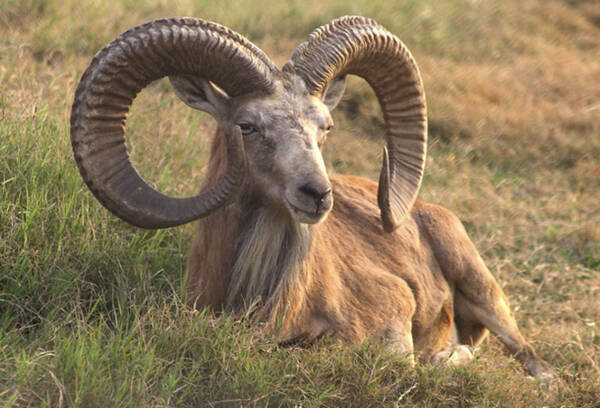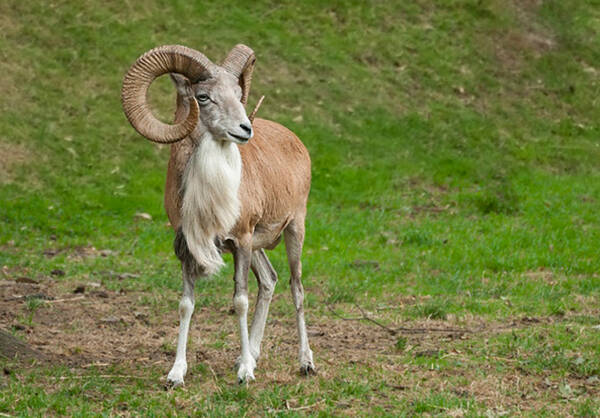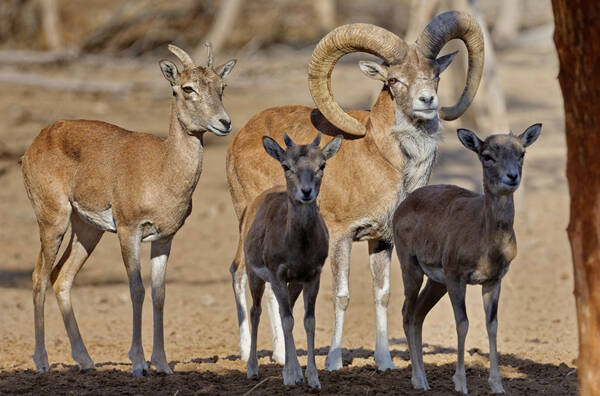Ovis vignei
IUCN
LCBasic Information
Scientific classification
- name:Ovis vignei
- Scientific Name:Ovis vignei
- Outline:Ungulata
- Family:Artiodactyla Bovidae Argali
Vital signs
- length:Shoulder height about 1 meter
- Weight:About 90kg
- lifetime:About 11 years
Feature
Has black and white saddle patches with a distinct white patch on the rump
Distribution and Habitat
The species is found in Afghanistan, northwestern India, central and eastern Iran, southwestern Kazakhstan, Pakistan, Tajikistan, Turkmenistan and Uzbekistan. Wild sheep from Oman are considered to be possibly introduced, with uncertainty about origin.
Inhabits moderate to very arid habitats, ranging in altitude from sea level in the Trans-Caspian Lowlands to over 4,000 m. In the Pamirs, Hindu Kush and Himalayas. Prefers hills, undulating terrain and gentle slopes, but also cliffs. Lives in grasslands and open woodlands, such as cold deserts with rare vegetation dominated by subshrubs of the genera Prunus, Pistachio and Juniperus. The species may also forage in agricultural fields. They use caves on slopes or cliffs for shelter or rest under shrubs.
Appearance
Males of the Viscounty's argali can weigh up to 90 kg and can reach up to 1 meter in height at the shoulder. The overall coat is brown, being lighter in summer than in winter. They have a distinct white patch on the rump. The species has black and white saddle patches. The male has a black neck ruff that is limited to the front of the neck and chest. The horns of males are large, while the horns of females are much smaller. The shape of the horns may be variable but tend to be arranged supracervically. The maximum horn length recorded is 990.6 mm and the maximum base circumference is 304.8 mm. The species has distinct antelope-like features characterized by a strong body and long legs.
Details
Ovis vignei (scientific name: Ovis vignei) is also known as Urial in English. There are 5 subspecies.

Ovis vignei is a gregarious sheep, and the group size can be as high as hundreds of individuals. In Iran's "Golestan" National Park, there are herds of more than 4,000, but the average size is about 29. Urine densities are higher near ranger stations, 0.15-21.77 per square kilometer. In spring and summer, herds are smaller and often sex-segregated. Sexually dimorphic, non-territorial, and promiscuous.
Viscounty's argali are primarily diurnal, spending most of the day foraging. They move throughout their range, but do not maintain territories. They live in groups, with individuals forming related groups. Herds usually consist of females, lambs, and young. Adult rams form separate male groups. Separation of the herd eliminates competition for food and reduces harassment of females. The herd has a social structure where dominance is based on size. Dominance relationships are particularly pronounced in herds of rams, where dominance is largely determined by horn size - the larger the horn, the higher the dominance rank.
In argali society, dominant males act as a stabilizing force by preventing younger males from harassing females. Young males are more aggressive and bullying than older males. Aggression between similar-sized Viscounts usually involves turning their heads and using their front legs. They do not lie on their hind legs before a collision.

Detailed information on communication in Viergrill's argali is lacking. However, it is known that males engage in aggressive physical contact, through which they establish and communicate dominance relationships. Tactile communication appears to exist. Females communicate their estrus status to adult males through chemical cues in their urine. In addition, mothers and lambs recognize each other based on scent, so olfactory communication plays an important role in this species.
The Verts' argali are herbivores, consuming a variety of unspecified plants, probably grasses and shrubs. They will also eat grains.
The Verts' argali has a polygynous mating system, but the male does not dominate the herd. During mating, the male slowly approaches the female in a stretched-out position. The female responds by squatting and urinating. The male then smells the female's urine and chemically determines if the female is in estrus. Females in estrus are possessed by the dominant male. After mating, the dominant male isolates the female from other males until she is no longer in estrus. Once the female is no longer receptive, the male leaves to find another female in estrus.

The reproductive cycle of the Viscount's argali begins with estrus in late November, and females give birth to one or two lambs in April-June. The estrus and lambing periods vary depending on the region where the species lives. Ewes are isolated from the herd before giving birth. After giving birth, female animals and their young will leave the herd for 3-7 days. During this time, the lambs grow, and both the ewe and her offspring recognize each other by smell. Females are usually able to bear their first litter after 2 years, and males become sexually mature at 3 years, but fully mature at 8 years. The maximum lifespan in the wild is 11 years.
The global population of the Versailles' argali may be in the range of 30,000 individuals. Population numbers do not include suspected hybrids between Asiatic argali and Versailles' argali occurring in Iran. Therefore, only entire provinces are considered if not otherwise specified. Population trends across its range are likely to be declining, with a possible decline of up to 30% after three generations.
Listed in the IUCN Red List of Threatened Species 2020 ver3.1 - Vulnerable (VU).
Protect wild animals and stop eating game.
Maintaining ecological balance is everyone's responsibility!








